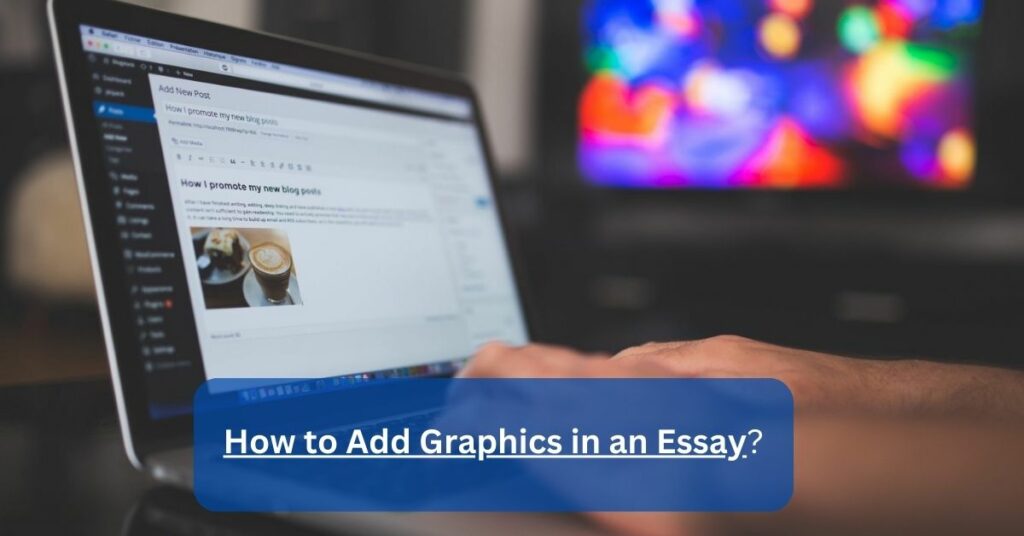How to Add Graphics in an Essay

Incorporating thoughtfully chosen graphics into your academic essay can be an extremely effective strategy for reinforcing key points, illustrating intricate concepts, and enhancing overall reader comprehension and engagement with your writing. However, simply inserting images arbitrarily without clear purpose is not likely to strengthen your work.
Care and intentionality is required to make judicious use of graphics that elevate the essay substantially. Enrich your essay by incorporating visuals with precision and relevance; for those seeking professional support in refining their graphic integration skills, Academized.com offers academic writers for hire who can provide valuable assistance in enhancing the visual appeal and impact of your essays.
First and foremost, closely analyze the assignment prompt and any supplementary instructions from your professor to ascertain expectations, restrictions and opportunities regarding visual elements in your submission. This crucial initial step provides essential framing and context for your decisions about if, when and how to integrate graphics for optimal impact.
Carefully Contemplate the Assignment Parameters
If the professor specifically encourages or permits the inclusion of graphics, excellent. This gives you license to brainstorm how best to do so for enhancing reader experience. However, be aware that some essay prompts expressly forbid formats other than plain text responses to avoid potential distraction or superfluous decorating. Determine your instructor’s exact expectations upfront so you can tailor your approach accordingly.
An explicit nod to visual elements in the prompt empowers you to analyze where graphics would make the most sense and how to interweave them fluidly with the textual content. On the other hand, defined restrictions to prose only suggest a more stripped down, exclusively text-based piece without supplements. This helps you concentrate ideas within the prescribed style parameters. With clear assignment framing in place, you can then determine if and how to incorporate graphics effectively.
If no guidance is provided either way, utilize your best judgment based on the prompt’s subjects and your instructor’s areas of emphasis. When in doubt, a polite query for clarification never hurts so you can submit your essay confidently. Just be sure to factor in response timelines related to due dates.
Enhance the visual appeal of your essay by skillfully incorporating graphics, ensuring they complement and amplify your written content; for expert advice and reliable support, explore insights provided by the best essay writing services to make informed choices about the graphical elements that elevate your academic work.
Carefully Consider the Graphic’s Purpose
Assuming visuals are permissible based on your assignment analysis, avoid selecting images arbitrarily just for decoration’s sake within your piece. Any graphics should connect directly to the essay’s central themes and thesis to enhance what you are communicating versus distracting. Determine clear reasons why each specific image furthers the reader’s understanding and comprehension of your key points.
For instance, an appropriately chosen graphic could:
●Provide clarification or concrete examples illustrating an abstract concept to reinforce meaning
●Offer additional evidence or support for a key argument you are making
●Draw a clear visual comparison or contrast between two connected ideas or positions
●Efficiently display pertinent numerical data trends through infographics versus blocks of text
●Show real-world examples or samples to readers to make connections with application
●Demonstrate cause-and-effect relationships between variables or historical timelines of events
These potential purposes all link tightly with using graphics to further emphasize essay relevance versus just decorative frills. Determine each image’s role in strengthening comprehension or bolstering discussion before deciding to incorporate it. Then double check your work to ensure the resulting graphics directly support your thesis within proper assignment parameters.
Choose Graphics Thoughtfully
When selecting visual elements for inclusion, carefully contemplate considerations like source reputability and image relevance. Images copied from questionable internet sources could diminish an essay’s credibility versus boosting it without thoughtful checks. Only utilize graphics from trusted repositories, reputable publications or your own edits when expectations allow.
Additionally, be discerning when assessing how truly pertinent an image is before working it into the essay’s flow. Ambiguous stock photos or random clip art weakens relevancy rather than clarifying intent. Unless directly tied to core content, avoid tossing in miscellaneous visuals merely intended to take up space on the page. Readers can sense when visuals have been added without clear purpose. Instead, be highly selective regarding pulling in graphics which mesh seamlessly with the surrounding discussion.
One final consideration when incorporating graphics is ensuring they complement the textual discussion without overwhelming it unnecessarily. Seek balance in blending images and prose so readers can easily toggle between consumable portions of each. If visual elements dominate the page substantially, key points may get lost amidst the efforts to decorate. Strive for adequate white space and strategic placement of graphics to smoothly accent the writing style.
Common Types of Graphics
Myriad options exist for visually representing concepts within academic essays. Beyond more basic tables, charts and graphs, consider all potential venues which could efficiently illustrate key lessons for readers. Some additional graphic formats include:
- Infographics using a blend of concise text and eye-catching images to communicate complex ideas or data sets visually
- Photographs, video stills or other pictorial images providing real-world grounding or relatable visual evidence
- Diagrams simplifying multifaceted processes into digestible and orderly graphical flows
- Flowcharts or organizational charts unveiling structural connections between interrelated components
- Formulas or models conveying intricate conceptual relationships mathematically
- Maps with annotations pinpointing geographical areas of relevance
The specific choices which make sense will vary extensively based on your unique essay focal points and content objectives. However, explore all visual teaching tools at your disposal to determine optimal fits for supplementing the points conveyed in words on the page. With some creative thinking, you may discover an inventive graphical solution which satisfies an assignment’s expectations while clarifying student comprehension simultaneously.
Strategizing Optimal Graphic Placement
In terms of location within the essay itself, consider when and where visuals would provide maximum benefit amidst the textual content you craft. Standard essay structure flows through an introduction, body paragraph development, and summarizing conclusion. In most cases, the meatiest opportunities exist within body paragraphs where core arguments unfold. However, certain images may further bolster understanding if strategically embedded to accent the set-up or concluding thoughts as well depending on relevance.
For the introduction, be very sparing about adding substantial visuals here since the priority involves clearly framing the forthcoming discussion for readers textually. An initial image could pique interest or provide an overview organizing graphic connected to the thesis if crafted thoughtfully. Just take care not to allow supplementary decorations to upstage the opening’s prime territory for establishing directional purpose before elaborating.
The essay’s body paragraphs offer ripe territory for incorporating graphics more robustly as key points unfold through assertion development and evidence integration. Place images within related paragraphs near text passages they purposely supplement or ground, allowing readers to toggle between mutually supportive elements seamlessly. Think cinematically in terms of camera angles alternating perspectives for emphasis while retaining focus on the central action overall.
Finally, as the essay conclusion synthesizes key takeaways, restraint with additional visuals once again allows the textual recap to take center stage.However, a thoughtful final graphic could serve to encapsulate the essay’s core themes with visual reinforcement. Just avoid entirely new visual content at this culminating phase so readers are not confused by late stage introductions diverting from the summary trajectory.
Writing Captions with Care and Intentionality
While strong images provide invaluable visual clarification and support as graphic elements, simply inserting pictures without context risks reader confusion or uncertainty about intent and relevance. Protect against such ambiguity by taking great care to write descriptive captions explaining each graphic’s significance specifically. Captions provide vital linkage helping readers comprehend images’ role amidst the discussion flow.
First, keep caption verbiage concise yet clearly descriptive regarding the core graphic takeaway. Identify which key point or concept is summarized visually without over-explaining unnecessarily. Brevity clarifies succinctly while excessive caption length competes with the visual element itself.
Additionally, captions should remain objectively neutral without directing readers exactly how to interpret the graphic’s meaning. Allow some subjective analysis latitude rather than imposing declarative “should” statements on viewers about perceived conclusions.
Of course, directly address relevance by explaining each graphic’s connection to key essay arguments within the captions you write. Spell out why visual analysis matters related to the paragraph themes without assuming inherent links will be intuitively grasped. Making relationships to central topics obvious strengthens comprehension substantially.
Finally, apply consistent formatting such as label numbering, citation requirements, and caption placement on pages regardless of graphic types incorporated. Uniform style signals purposeful integration amidst essay content rather than disjointed embellishments. Streamlined presentation keeps the focus on bolstering discussion flow through imagery rather than interrupting it unnecessarily.
Strategic Text Integration with Graphics
Surrounding graphics, consider adding transitional text guidance to introduce an impending image or table, followed by reinforcement of its key takeaways afterwards.
Set the visual element up with a sentence or two previewing what readers are about to study and why it matters related to paragraph evidence goals. This primes readers to view images actively rather than passively skim past them as irrelevant decoration.
Then, thoughtfully incorporate a sentence following graphical content to solidify connections being made. Guide readers explicitly linking imagery back to the paragraph’s central point or theme using clarifying language. Visual learners as well as text-based processors will appreciate the blended analytical integration helping everyone draw purposeful conclusions aligned to arguments presented.
Polishing Essay Flow with Graphics
After initially drafting body paragraphs and inserting graphics amidst the discussion, step back to reassess flow quality, visual resonance and impact holistically before final submission.
Review the images included thus far asking whether each example still integrates tightly with the presented text context based on full essay analysis. Eliminate any decorative graphics which now seem diversions rather than priorities upon second read.
Additionally, vary visual placement appropriately throughout longer pieces to alleviate dense blocks of text which can visually overwhelm readers and diminish engagement. Allow graphics to provide rhythmic visual relief as one moves through lengthy arguments.
Verify formats, sizes, resolutions, coloration, caption details and other graphical specs remain aligned uniformly throughout the document. Consistency signals an essay largely under authorial control rather than a patchwork of fragmented parts. Apply universal templates keeping style choices consistent.
Carefully assess page layout spacing around each incorporated graphic, adjusting as needed to prevent awkward gaps or crammed configurations that detract from discussion flow. Give visuals room to breathe while preventing orphaned text sections stranded apart from anchoring passages. Reviewing essay formatting in “Print Preview” often lends helpful perspective pinpointing spacing issues needing tweaks for refinement.
By thoughtfully fusing relevant graphics and descriptive captions into an essay, a writer guides readers to comprehend key points through textual and visual blending they can actively connect with. Well matched imagery saves many words in illustrating complex processes. Strategically maximize this efficiency to engage audiences while also showcasing mastery around concepts central to the essay’s purpose. Allow prose and graphics to play off each other’s strengths for optimal assignment results.



